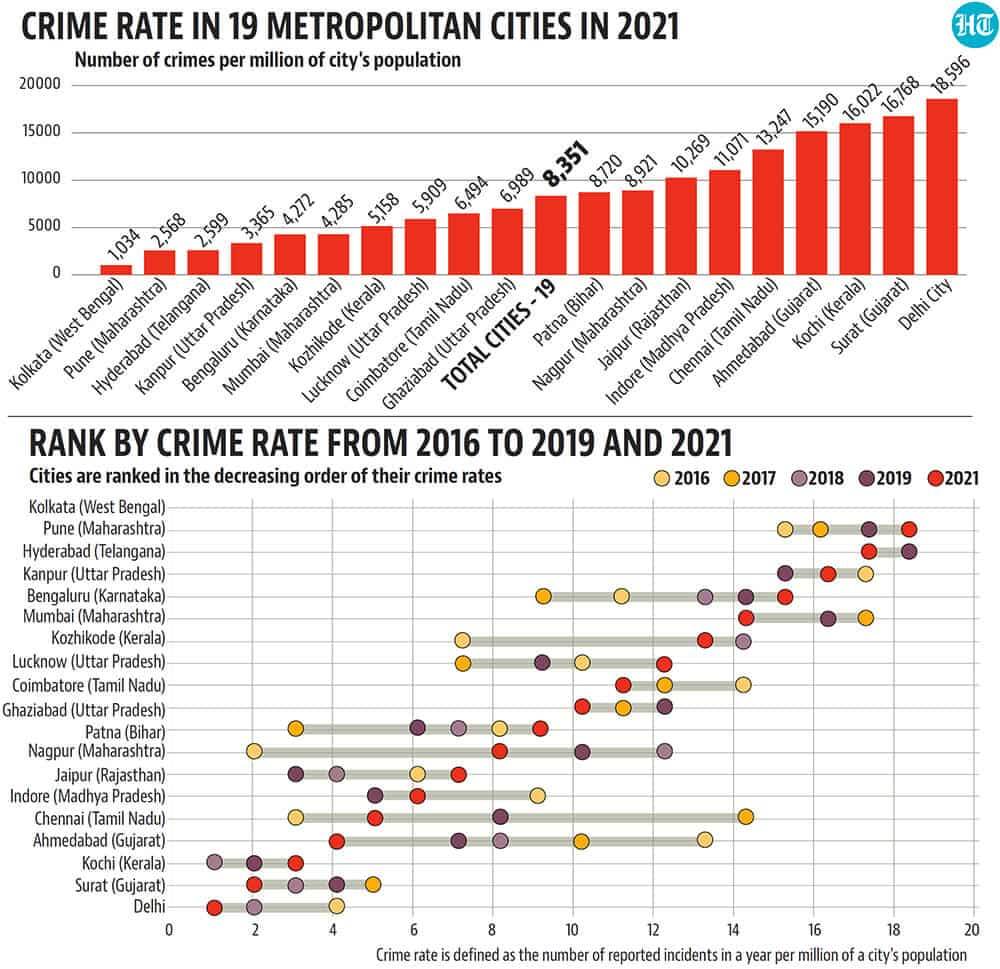Number Theory: Which are India’s safest (and most unsafe) cities?
The 2021 Crime in India (CII) report published by the National Crime Records Bureau (NCRB) shows that Kolkata had the lowest crime rate among 19 major cities in India, and Delhi had the highest.

Which is India’s safest city? The 2021 Crime in India (CII) report published by the National Crime Records Bureau (NCRB) shows that Kolkata had the lowest crime rate among 19 major cities in India, and Delhi had the highest. Crime rate is the number of criminal incidents reported in a year per million of the population. The actual picture, to be sure, could be very different from what the headline crime rate numbers suggest. Here are charts that explain this in detail.
1) The crime rate in Delhi is 18 times Kolkata’s…
The 2021 CII report gives crime rates for 19 of India’s metropolitan cities. The numbers show that Kolkata is the safest city in the country and Delhi is the city with the highest crime after adjusting for population. This data also shows there is significant variation among these major cities.
For example, the crime rate in Delhi, the city with the highest crime rate, is almost 18 times the crime rate in Kolkata, the city with the lowest crime rate. A comparison with the previous CII reports shows that while most cities changed one or two ranks in the past five years (excluding lockdown-affected 2020), few have shown significant change when it comes to crime rate.
To be sure, Ahmedabad, which has the 13th-highest crime rate in 2016, gained nine spots to rank fourth in 2021. Kozhikode, with the seventh-highest crime rate in 2016, dropped six spots to reach 13th in 2021. Similarly, Nagpur, the city with the second-highest crime rate in 2016, dropped six spots to end up on the eighth spot in 2021.

2) …but this needs to be read with a caveat on population…
Calculation of crime rates requires availability of up-to-date population figures. India conducted its last census in 2011, and the 2021 census has been delayed without any clarity on when it will be conducted. While the CII report does a relatively better job at estimating crime rate at the all-India and state-wise level – it takes population projections for the year – the city-wise estimates are pretty obsolete. Because there are no population projections at the city level, even the 2021 crime rate for cities is based on 2011 population estimates.
This means that the population numbers are largely underestimates, which means that the crime rate numbers are likely to be overestimates. What makes the city-wise rate even more unreliable is the fact that they have shown very different trajectories of population growth in the decade between 2001 and 2011.

3) …and one on the efficacy in recording crimes
As is the case with official statistics, crime numbers also only capture what enters the official records. This means that cities which are proactive in filing cases will tend to show a higher crime rate. As is well-accepted among experts, both the attitude of law enforcement towards recording crimes as well as the inclination to report a crime to the police can affect this.
While there’s no conclusive way to prove whether or not these factors have an impact on the numbers, a look at crime rates for different kinds of crimes shows a pattern which supports the argument that reporting and recording may have a role in determining crime rates. For example, while these cities show a small divergence when it comes to crime rate for murder (which is very unlikely to be not recorded or reported), the spread is many times larger for a crime such as rape (where the scope for non-reporting is much larger).

4) Efficiency in charging for crimes is another story
CII also gives information on charge-sheeting (the filing of charges before a court) rates across cities, offering a view on the efficiency of the police in disposing registered criminal cases. It is defined as the share of cases charge-sheeted by the police out of total cases disposed by them. A comparison with the previous years indicates a rise in the overall charge-sheeting rate in 19 cities to 67% in 2021, from 57% in 2019, but this number is three percentage points lower than what it was five years ago (70% in 2016).
What is more alarming is the fact that Delhi, the city with the highest crime rate in 2021, has the lowest charge-sheeting rate (34.1%) in 2021. However, this is not the case for other cities with high crime rates. Surat, with the second-highest crime rate in 2021, has the highest charge-sheeting rate at 98% in 2021. And Kochi, with the third-highest crime rate, has charge-sheeting rate as high as 97.7% in 2021.

Sandeep Raiza — Content Writer, Website Designer, SEO Strategist, and WordPress Expert AI specialist delivering impactful digital solutions that drive business growth.Combining creative storytelling with technical expertise.
